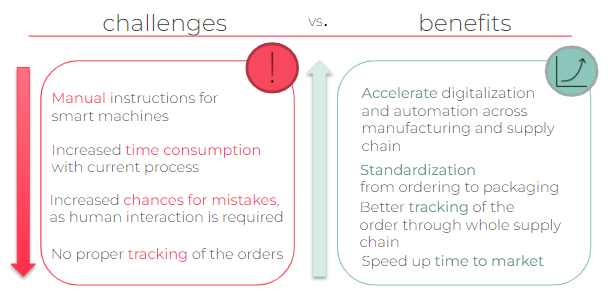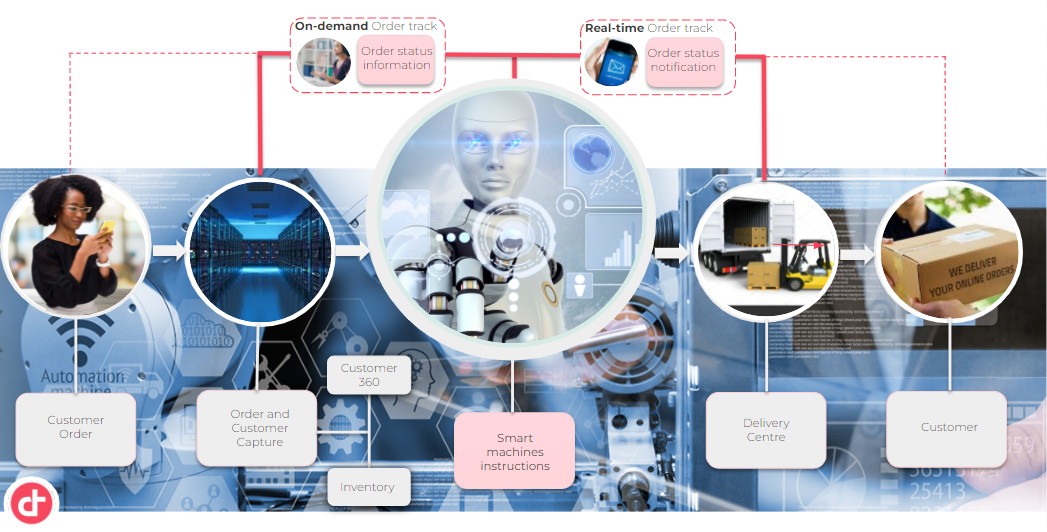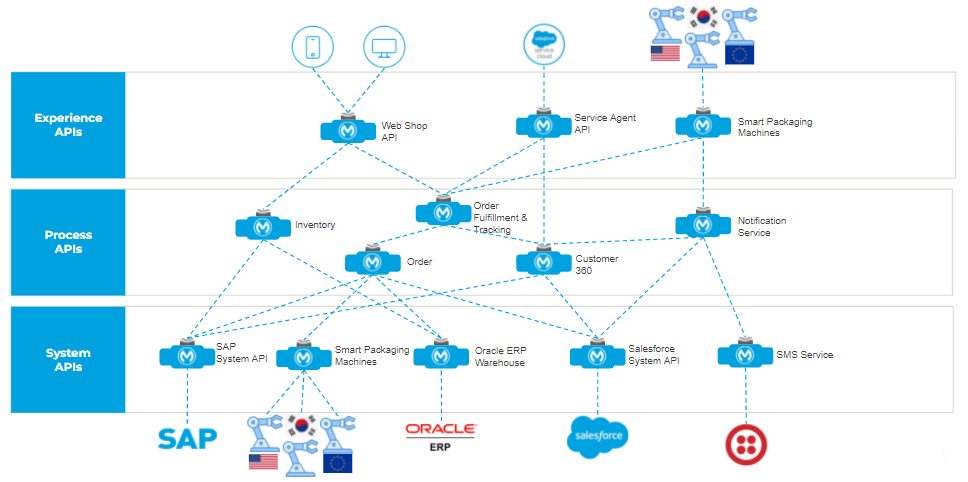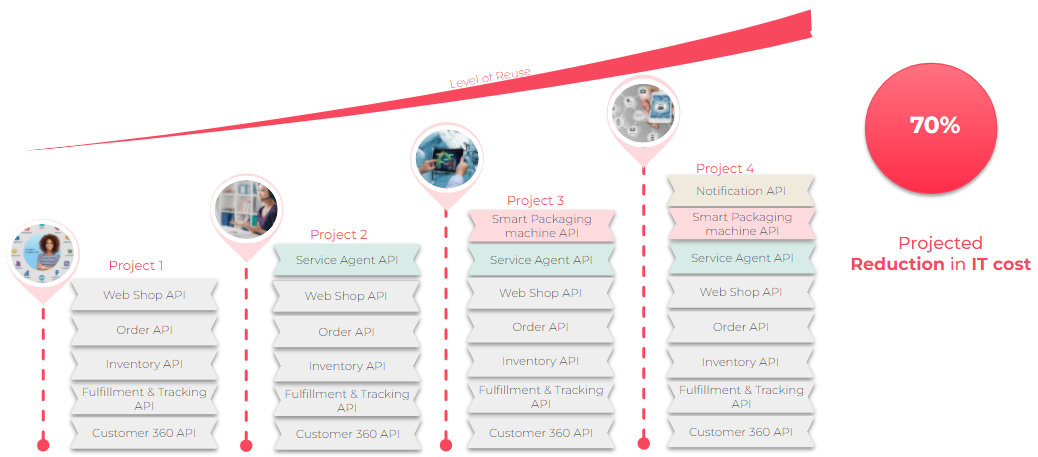Regardless of industry, each area of business is facing challenges shaped by specific customer demands and problems resulting from it.
In this blog, we will deal with the challenges related to the manufacturing industry and the challenges identified for the specific client. Also, we will present our proposed solution that has helped the client to overcome his difficulties, as well as the possible extensions on the solution itself to even more improve the business processes and customer satisfaction.
Industry challenges that shape manufacturing market
On a global level, manufacturing and logistics continue to grow. This sector is highly diversified, and it’s evolving in dramatic ways, like increased demand for new products and services, increased demand for after services, and expansion into new markets. In the picture below you can see the main challenges of modern industry, and what are the industry pain points that shape the industry market.

The first one is growing customer expectations. Most of the customers now expect to use mobile or web portals during the decision-making process. Another interesting trend is the growing demand for innovative products and services. At the time of speaking, 30% of the value of manufacturing organizations is made of software and services.
The next one is the growing requirement for operational efficiency, which became one of the main reasons for investment in digital transformation initiatives. This is closely related and coupled with the new age trend – the internet of things. Modern industries are using IoT to operate more efficiently, to better understand customers, to deliver enhanced customer service, improve decision-making and increase the value of their business.
Complex demands require even more complex integrations of numerous different systems in order to deliver the final product or service, so the business owners need to think about finding a way to solve information exchange barriers and massive complexity between ERP systems like SAP, legacy manufacturer systems, smart machines, logistic centers, and delivery centers systems Central. The crucial in achieving it is data – accessible, secure, and in real-time.

The effect of globalization and now the pandemic additionally, resulted in the world becoming an even bigger global marketplace. Times are changing rapidly, so do the technologies, customers, and ways we meet their demands. In a world dominated by digital technology, the IoT together with Integration, plays a prominent role in these changes.
On top of all these previously mentioned challenges that are already well known and ongoing for a long time, suddenly, there are certain ‘new reality’ challenges that are complicating things for the manufacturer and logistics even more. These are the challenges related and produced by the ‘new reality’ where the Covid pandemic is in focus and the post-Covid effects cannot be ignored. During Covid, especially in the time of lockdown, the usage of the remote ordering of all types of products, from medicaments to food and clothes, has significantly increased.
The effect of globalization and now the pandemic additionally, resulted in the world becoming an even bigger global marketplace. Everyone was using the benefits of smart devices in terms of shopping, ordering, delivering, and real-time order tracking. But the need to stay at home, and be socially isolated has pushed the entire population to rely on technology. Furthermore, in certain moments this channel was the only one possible for people to do their purchases.
The combination of these already well-known challenges and new reality challenges has led the companies to be, once again, in front of one ‘old but new’ challenge – to speed up even more time to market process.

Customer overview and challenges
In the boxes below challenges and benefits for the specific customer are listed, from the area of manufacturing, packaging, quality, testing, and logistics.
These are some challenges that can be applicable for all the manufacturers, regardless of the product type they are producing and delivering to the customers.
It is the packaging of the products itself that was recognized as the main bottleneck of the supply chain process. After the products are produced and prepared for delivery to the end customer, the process used to require manual human intervention in terms of packaging; machines needed manual settings by the human in order to do packaging actions.
Besides that, the point that even more disrupted the whole process was the high chance for human mistakes. The waiting time for completing delivery and correction of the mistakes made the process repeat, which resulted in lengthening the total time needed for delivering a product to the customer’s address. Additionally, no proper tracking of orders was spotted. The orders data was siloed rather than distributed and accessible through the whole supply chain.
There was a need for change, in order to improve their business and satisfy the challenges mentioned at the beginning. The main benefits that arise from solving these problems are explained in the following.
One of the main gains is the acceleration of digitalization and automation across manufacturing and supply chain, using the IoT concept, and integration with smart machines. On the other hand, introducing the proper data standardizations and distribution through the whole process led to improved tracking of the orders. Eventually, this boosted the effect on time to market in a positive manner, which is directly related to customer satisfaction at the end of the story.
Automation – from ordering to delivery solution
As we’ve concluded earlier there is a tremendous opportunity for manufacturing and logistics organizations to take advantage of innovations in IoT. Here we represented the user journey, for one use case, where integration with smart machines is used to deliver additional value to customers, along with satisfying and minimizing the challenges mentioned at the beginning.

The customer journey starts with ordering the products online, using mobile or web portals.
Submitted orders are captured along with customer information, which enables storing inventory data and creating the customer 360-view. Besides, the main & key idea of the process is also implemented – integration with smart machines.
In order to rationalize and optimize the current procedures and operations, an immense improvement was achieved by using IoT and integration concepts. Using this approach, once the customer has submitted an order, inventory and customer data are captured and inputs are translated into instructions readable by the smart packaging machines. After that, the order is ready to be picked up by the delivery center and to be distributed to the end client.
As an extension of this cycle, our proposal is to further improve this use case with the new processes for informing the customer about his order status. The information can be requested on-demand, the customer calls a service agent to receive the information about his order, or it can be done automatically, through the notification service. This way, customers can track the orders in a real-time manner. Connected with all braking points in the process, notification API will inform customers when the status of an order is changed. The IoT integration concept, along with the service providing additional values to the customers, work very well together in the context of implementing end-to-end IoT business solutions.
API-led connectivity approach in manufacturing
In the picture below you will see the same story described using MuleSoft recommended approach – API Led connectivity.
In the experience layer, there is a webshop API, which is exposed and serves as a channel for the customers to order their products through the web or mobile apps. Once the order is submitted, in the process layer you can see how the data is distributed and which APIs are using it. Mostly, these are the Inventory and Order Fulfillment and Tracking APIs, where Order Fulfillment and Tracking API is further leveraged to Order and Customer 360 APIs. These APIs are in charge of communication with Salesforce, and combined together are constructing a unique end-to-end picture of the customer’s journey and experience. Also, on the system layer part, you can see the SAP and Warehouse APIs, which are this way unlocked and discovered to the Web Shop API.

As part of the improvement in customer support, we extended our experience layer into one more possible channel – service agent. Connected with Order Fulfillment and Tracking and Customer 360 APIs, Service Agent API can access and dispose of data and information that are already there. Without additional complexity in logic, Service Agent API is completely reusing the process APIs as is, but for a new purpose – to provide the requested information to the client who contacted them.
In this way, we mostly covered the factors and challenges directly impacting the end customer – web portals and instantaneously reacting to customer demands through service agents.
Application Networks Provide Compounding Benefits

Across each successful project, we can reuse the existing APIs built in the previous project phase. This helps in accelerating the innovations we want to deliver in the future.
- Project 1 is the basic one, with the core functionalities when it comes to orders, and especially creating customer profile 360 view in Salesforce.
- Within the next project we are introducing Service Agent API, to improve our customer experience. Service Agent API by reusing already created APIs is now delivering additional value to the customer in terms of quick reaction, prompt, and correct response, to the customer.
- The next one, the main API, around which the initial idea was created, is Smart Packaging Machine API. Connected with previously created Order API, Smart Packaging Machine API is now receiving the information needed for smart machines to complete the orders packaging.
- In project number 4, we are introducing the completely other direction of the integration of Smart Packaging Machine API, now as part of the experience layer, that will be exposed in order to use a completely new Notification API, whose aim is to notify the customer over SMS that his order is packed and ready. This is possible, again, only by reusing the previously established APIs, and by consuming the customer data From Customer 360, Notification API will complete its role.
This approach is enormously accelerating the quick introduction of innovations in parallel with reducing the cost and time, which is essential to success.
Conclusion
For quite a long period of time, industries have embraced digital technology to better understand and manage resources, improve safety, and increase efficiency. In fact, the field of Industrial Automation (IA) has given rise to this third industrial revolution for nearly half a century. The evolutionary trends in cognitive technologies and “smart” enhancement of things, signals an era of intensified warehouse robotization. Times are changing rapidly, so do the technologies, customers, and ways we meet their demands. In a world dominated by digital technology, the IoT plays a prominent role in these changes. Integration with it is inevitable and can be imperative and essential for survival, so the business owners need to think about it and make a move in this direction on time.
